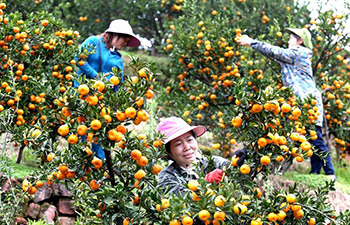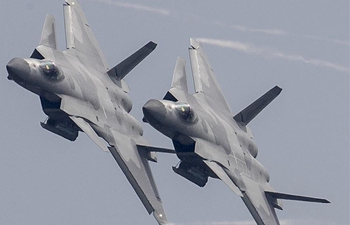KAMPALA, Nov. 15 (Xinhua) -- It is that time of the year when Ugandans get to enjoy the nutritious insect snack locally known as Nsenene, the local name for grasshoppers, which arrive in large swarms every November-December.
In Makindye, a Kampala suburb, the night is lit up by strong lights, almost after every 100 meters. Groups of men have set up traps for the grasshoppers which they will later sell in sacks to traders. The traders in turn sell to vendors who clean them and supply customers in different markets around the capital Kampala.
As one moves along the city roads, men both young and old are seen carrying big buckets of the fried delicacy while calling out, "Nsenene, these ones are fresh."
Both pedestrians and motorists stop by the roadsides to by the snack, which is commonly sold in packs of 1.3 U.S. dollars each. At certain locations in the city center, the sweet aroma attracts you to women frying the Nsenene in deep oil.
SETTING TRAPS
Arnold Makubuya, a grasshopper trapper in Kampala, said for one to get a good harvest, they need iron sheets, bulbs of about 200 watts and well cleaned empty oil drums.
"You get three strong bulbs depending on the size of your area and raise them up to about 10 meters high. You then spread out iron sheets vertically on built-up pieces of wood while slanting into the empty oil drums," Makubuya told Xinhua in an interview.
He said the grasshoppers are attracted by the strong light and once they get tired of flying around, they fall onto the iron sheets and slide into the drums.
"Near the traps, you must light up some pieces of wood which produce smoke that goes up and chokes the insects, forcing them to fall into the traps," Makubuya said.
As the insects gather in the drums, the trapper pours them into sacks to prevent them from flying away. It is these sacks that are taken to the market and sold to vendors.
Sometimes the wholesale buyers are waiting with their trucks once the sacks accumulate, they ferry them away.
George Zziwa, a wholesale dealer, said they buy a sack at about 50 dollars or even less, depending on the day's catch.
"So far they are still a little bit scarce because the season has just set in. Our colleagues from Masaka (in central Uganda) and Kabarole district (in western region) are making good cash. We hope to make more in December," Zziwa told Xinhua.
According to Zziwa, the dealers in western and central regions are buying a 30kg sack of grasshoppers at about 25 dollars and selling it at close to 80 dollars.
PREPARING THE SNACK
Esther Arinaitwe, who describes herself as a devoted addict of grasshoppers, said on a good day she can consume a half kilo of the snack.
"I like preparing them myself. After buying the fresh grasshoppers from the market, I wash them in warm water before putting on the frying pan. I make sure the fire is not so much lest they get burnt. Grasshoppers produce their own fats so the only thing I add in there are the onions," Arinaitwe said.
The frying goes on for about 20 minutes before the snack is ready to be eaten.
Joseph Mulema, another city dweller, said he likes the grasshoppers accompanied with a bottle of beer.
"I like eating them while sitting out with friends in the evening. They go well with a bottle of beer, just as you would eat roasted ground nuts," he added.
A story is told how men had tricked women into not eating the delicacy. It was a high-held superstition in Uganda that women would become barren if they ever ate the grasshoppers. But with modernity setting in, both men and women alike, line up for them either in markets or at roadsides.













